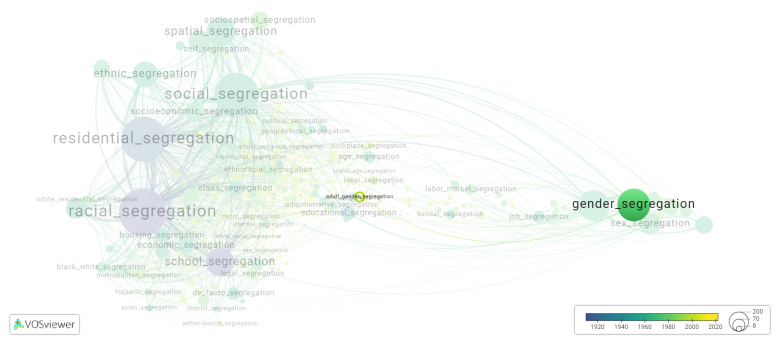Adult gender segregation: Difference between revisions
(Creating page) |
(Creating page) |
||
| Line 18: | Line 18: | ||
[[File:adult_gender_segregation.png|780x780px]] | [[File:adult_gender_segregation.png|780x780px]] | ||
This visualization is based on the study [[How_to_cite_Segregation_Wiki| The Multidisciplinary Landscape of Segregation Research]]. | |||
For the complete network of | For the complete network of interrelated segregation forms, please refer to: | ||
* | * [https://tinyurl.com/2235lkhw First year of publication] | ||
* | * [https://tinyurl.com/2d8wg5n3 Louvain clusters] | ||
* | * [https://tinyurl.com/223udk5r Betweenness centrality] | ||
* | * [https://tinyurl.com/244d8unz Disciplines in which segregation forms first emerged (Scopus database).] | ||
==References== | ==References== | ||
==Notes== | ==Notes== | ||
Revision as of 07:48, 10 October 2024
Date and country of first publication[1]
2009
United States
Definition
Adult gender segregation refers to the separation of individuals based on their gender in various aspects of adult life, such as social, occupational, or recreational settings. This can occur voluntarily due to personal preferences or cultural norms, or it can be enforced by laws, traditions, or institutional policies.
In some cultures or communities, gender segregation is common and accepted as a way to maintain modesty, privacy, or social order. For example, in certain religious or conservative societies, men and women may be separated during religious ceremonies, social gatherings, or public spaces.
Gender segregation can also occur in occupational settings, where certain industries or professions are predominantly dominated by one gender. Examples include nursing (primarily female) or construction (primarily male). This can lead to limited opportunities for individuals of the opposite gender who may want to enter these fields.
Critics argue that adult gender segregation reinforces gender stereotypes, perpetuates inequality, and limits opportunities for gender integration and collaboration. They argue that it is important to challenge and question these traditional norms to achieve gender equality and create inclusive environments that allow individuals of all genders to thrive and participate fully in all aspects of society.
See also
Related segregation forms
Adult gender segregation is frequently discussed in the literature with the following segregation forms:
This visualization is based on the study The Multidisciplinary Landscape of Segregation Research.
For the complete network of interrelated segregation forms, please refer to:
References
Notes
- ↑ Date and country of first publication as informed by the Scopus database (December 2023).
At its current state, this definition has been generated by a Large Language Model (LLM) so far without review by an independent researcher or a member of the curating team of segregation experts that keep the Segregation Wiki online. While we strive for accuracy, we cannot guarantee its reliability, completeness and timeliness. Please use this content with caution and verify information as needed. Also, feel free to improve on the definition as you see fit, including the use of references and other informational resources. We value your input in enhancing the quality and accuracy of the definitions of segregation forms collectively offered in the Segregation Wiki ©.
Adult gender segregation appears in the following literature
Messner M.A., Bozada-Deas S. (2009). Separating the men from the moms: The making of adult gender segregation in youth sports. Gender and Society, 23(1), 49-71. SAGE Publications Inc..https://doi.org/10.1177/0891243208327363
Messner M.A., Bozada-Deas S. (2018). Separating the men from the moms: The making of adult gender segregation in youth sports. No Slam Dunk: Gender, Sport and the Unevenness of Social Change, 160-179. Rutgers University Press.https://doi.org/

